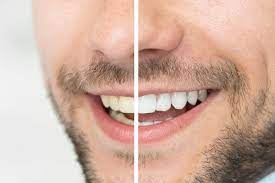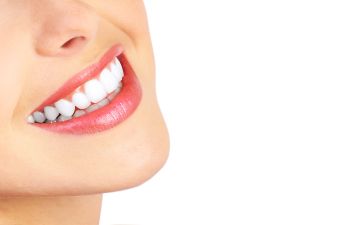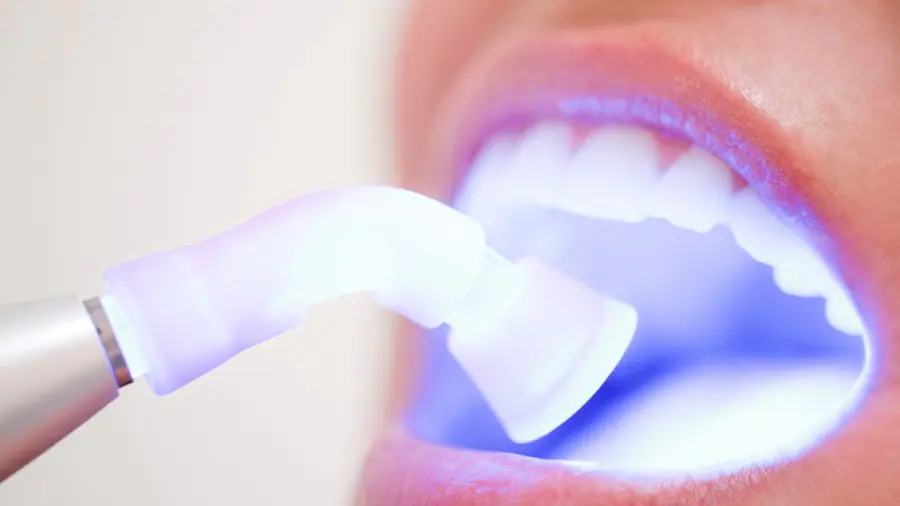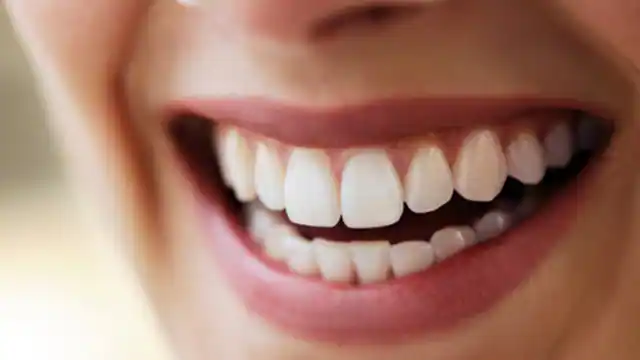Bleaching or teeth whitening dubai is one of the general dental services. Based on the definition of authoritative dental authorities, the scaling method of teeth whitening leads to the return of the color of the teeth to the natural state, and bleaching leads to the brighter than the natural state of the teeth. Teeth whitening includes steps such as:
- Brushing with whitening toothpaste
- Laser teeth whitening
- Use of bleaching tape
- Use of whitening gel
Currently, the use of teeth whitening services has many applicants. With age, small cracks appear on tooth enamel. These cracks become places where bacteria accumulate and change the color of the teeth over time. Teeth whitening methods remove these contaminations and bacteria and the teeth become white again.
Table of Contents
What is the difference between teeth whitening and bleaching?
When we make the teeth whiter than the natural state, we call it “bleaching“. But normal teeth whitening, which leads to the return of the teeth to their original color, is called teeth whitening. Therefore, using a whitening toothpaste can also help this process. But to perform bleaching, special bleaching materials are needed, and this process cannot be done with a normal bleach.
Causes of tooth discoloration and dullness
Depending on whether the tooth discoloration and tooth discoloration is internal or external, various factors are involved. The causes of internal or external teeth are as follows:
External tarnishing of teeth includes discoloration and damage to tooth enamel. This condition is caused by factors such as consumption of inappropriate foods and drinks. Alcohol, tobacco, colored and carbonated drinks lead to a change in the color of the tooth surface and the outer surface of the tooth is dull. If this problem is treated quickly and teeth whitening is done, there is no need for bleaching. Also, the lack of timely treatment of the change in the color of the outer surface of the tooth leads to damage to the inner surface of the tooth.
Internal turbidity and change in tooth color may be caused by intrinsic or acquired factors. Some people inevitably experience discoloration of the inside of their teeth as they age. But most of the people suffer from internal color change of the teeth due to acquired factors such as the use of some drugs or trauma and caries. The use of tetracycline in periods of life and excessive use of fluoride also lead to the occurrence of internal discoloration of the teeth. Normally, this type of color change cannot be treated with bleaching methods. Therefore, the use of tooth restoration methods such as veneer and composite is suggested.
Instant teeth whitening with light
Instant teeth whitening with light or laser teeth whitening is actually done with strong light radiation. This method is used in dental offices and clinics and is not a home method. In this method, LED light or plasma arc is used. Among the lights used for teeth whitening, halogen light is superior. Halogen light gives good results for teeth whitening. A light is suitable for this purpose, which stimulates the peroxide molecules well and does not damage the dental pulp.
In this method, a blue light is used, which has different wavelengths and can be adjusted. Each of these wavelengths is tuned for hydrogen peroxide reactions. These steps are done within 6 to 15 minutes and with degrees of 25 to 38%. It is interesting to note that ultraviolet rays and heat are removed from this type of light and laser. Each teeth whitening session at the dentist lasts between 30 minutes and one hour.
Durability and durability of teeth whitening and bleaching
To make the results of your teeth whitening treatment last longer, your dentist will likely offer you the following suggestions:
- Using methods to maintain the whiteness of the teeth, which is done immediately after this method or at specific intervals such as once a year.
- Avoiding foods and drinks that darken the color of the teeth. Doing this should be done for at least one week after teeth whitening.
- Whenever possible, use a straw to consume drinks that darken teeth.
- Maintaining good oral health by brushing and flossing after eating and before going to bed
Will bleaching make the teeth sensitive or increase their sensitivity?
Yes, but not permanently! In some cases, the teeth become slightly sensitive while using hot and cold foods or drinks, which of course is temporary and completely transient, and after that the teeth will return to normal.
Treatment of sensitive teeth after teeth whitening
Sometimes after whitening treatments, teeth become sensitive. If this happens to you, there are ways to ease the pain.
Use toothpaste for sensitive teeth: Toothpaste for sensitive teeth is made with raw materials such as potassium nitrate, which reduces the pain associated with sensitivity.
Gum: Scientists have noticed that more saliva is produced when chewing gum and the act of chewing distracts people from pain.
Give up whitening for a while: Give your teeth a break and don’t use whitening products.
Use of anesthetics: You can use anesthesia for 10 to 30 minutes after each use of bleaching agents.
Dietary changes: Avoid eating and drinking very hot or very cold foods for several days in a row.
Change your toothbrush: Using a soft toothbrush can help treat tooth and gum sensitivity.
Can sensitive teeth be whitened?
In fact, it is your dentist who will make the final decision about this. After examining the physiological condition of the applicant’s teeth, he determines whether he can bleach his sensitive teeth or not. Usually, for this group of people, weaker materials are used with longer distances. You may have a high sensitivity to substances that contain peroxide, in which case your doctor will suggest other methods to whiten your teeth besides using bleaching agents.
Is the teeth whitening treatment dangerous?
No, bleaching is not a dangerous and harmful method for your teeth and gums. We have done many cases of bleaching so far and we have not seen an example of damage to the teeth. This method has been in the field of dentistry for nearly 20 years, and so far no reports of damage or even risk of damage to teeth and gums have been reported.
The cost of teeth whitening
The cost of teeth whitening will be different depending on the method and the items. Also, the place and area where teeth whitening is done will be effective in determining this cost.
To save the cost of teeth whitening, follow the mentioned points for longer duration of bleaching. Due to the fact that most people drink a lot of coffee and tea daily, staining and yellowing of the teeth is inevitable. Therefore, you will need to spend money on teeth whitening at least once a year.

Methods of preventing teeth discoloration after whitening
After completing the teeth whitening treatment, there are several steps you can take to keep your smile white.
Avoid staining foods and drinks: coffee, tea, sports drinks, hard candies, berries, and tomato sauce are all foods that can cause tooth discoloration and sensitivity.
Use a straw: When drinking liquids, use a straw to remove food dyes and allergens from your teeth.
Avoid smoking: smoking can change the color and sensitivity of the teeth. Quitting smoking can help your teeth shine and be healthy.
Use of waterproof lipstick: Women are advised to use a lipstick that is waterproof and does not leave a mark on their teeth, or not to use lipstick for a few days after teeth whitening.
Whitening toothpaste: change the type of toothpaste and with this change, double the bleaching effect and enjoy the whiteness of your teeth for a longer time.
Frequently asked questions about teeth whitening and bleaching
1- What dental problems is bleaching suitable for?
Teeth that have turned yellow due to eating colored foods are the most responsive to bleaching.
2-Is it possible to perform bleaching for children and teenagers?
Basically, bleaching is not prescribed for baby teeth, but bleaching with carbamide peroxide can be prescribed for teeth that are discolored due to trauma and damage.
3- How long does bleaching last on teeth?
Many factors have an effect on the durability of teeth whitening due to bleaching. The minimum durability of bleaching is normally 1-3 years, sometimes it has lasted up to 10 years. Drinking a lot of strong coffee and tea, smoking, using a lot of soft drinks and not paying attention to oral and dental hygiene will reduce the duration of bleaching.
4- Is the color change caused by smoking and nicotine fixed and treated by bleaching?
It is not easy to remove stains and discoloration caused by cigarettes and nicotine. These stains are superficial at first, and if left untreated, they penetrate into the teeth and become internal discoloration. By using 10% carbamide peroxide at night for 1 to 3 months, stains caused by nicotine can be removed.
5- How does bleaching make the teeth lighten?
Hydrogen peroxide and carbamide peroxide penetrate into the enamel and dentin, which is not only a surface color changer, but also causes an internal color change in the tooth. This treatment brightens tooth color without affecting tooth hardness during an oxidation process.
6- What are the most important side effects of bleaching?
One of the most common problems is the sensitivity of a person’s teeth to hot and cold foods (dental sensitivity). The next thing is not fulfilling the wishes of patients who want very bright teeth.
7- What care should be taken after bleaching?
After teeth bleaching, minimize the consumption of cigarettes and food coloring substances such as tea and coffee, and if you do, be sure to rinse your mouth immediately.
8- What are the steps before bleaching?
Before bleaching, you need to repair decayed teeth. You should know that bleaching does not affect fillings, coatings and laminates. Before bleaching, if there is a crime, doing a crime will help to get a better conclusion.




